Streamline your document workflow & close deals faster
Get personalized 1:1 demo with our product specialist.
- Tailored to your needs
- Answers all your questions
- No commitment to buy
Schedule your free live demo
If you’re shopping for the best electronic signature solution this year, DocuSign may be the first stop on your search.
You might even consult the DocuSign pricing page to see if the cost of the platform is affordable for you.
But just looking at one set of pricing plans won’t help you figure out the best e-signing solutions on the market or how to incorporate them into your workflow.
So we’ve done the hard work for you.
We took a look at eight of the biggest e-signature solutions on the market today and compared everything they have to offer.
Let’s take a look!
Key takeaways
- DocuSign is a strong e-signing platform with great solutions for businesses of all sizes.
- Limitations on DocuSign plans can force users into pricing tiers that don’t meet all their needs.
- Many DocuSign alternatives offer additional features (PDF editing, file storage, document creation, etc.) in addition to e-signing.
How we sourced our data
For big comparison articles like this, our team spends hours sifting through the offerings provided by these services.
We check pricing pages, support documentation, ask questions, and much more.
Because this is a data-based article, we focused solely on the facts.
We’ve also personally tested and sampled many of these platforms as part of our research process.
Our team compared subscription plans, the features of each e-signature software platform, and at what price points those features were available.
Then we matched that data to different DocuSign pricing plans along the way to make everything easier to compare and contrast.
About DocuSign alternatives
In order to provide the best analysis of DocuSign’s pricing, this article compares DocuSign to various other platforms based on tiers and feature set.
While we occasionally offer alternatives to DocuSign here, our primary DocuSign alternatives article provides a clear platform-to-platform comparison that will be useful for users in search of the best e-signing tools.
A quick word about envelope limits
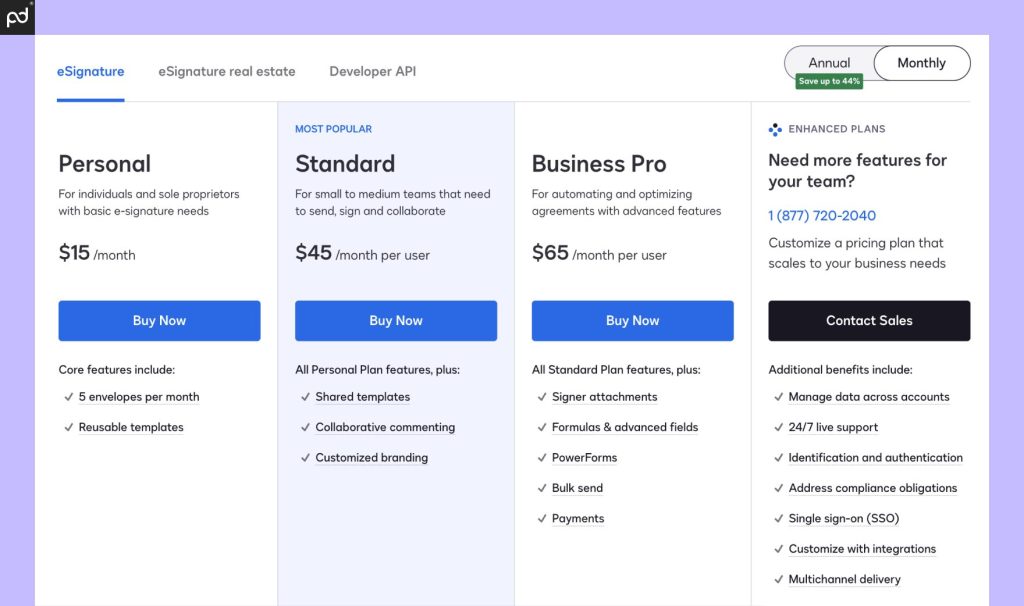
Before you begin comparing DocuSign with the other competitors on our list, it’s worth taking a moment to talk about user restrictions and usage limits.
These limits are often overlooked and can have a strong impact on how users interact with their signing platform.
What are envelope limits?
In a nutshell, an envelope or transaction limit is a tool that many e-signature companies use to cap the number of documents users can send over the course of a year.
These limits can be a major drawback for companies planning to use DocuSign and other platforms for bulk distribution or as a core part of their main business function.
That’s because they severely restrict the number of documents that can be sent using the software.
These limitations vary from company to company.
For example, regardless of which DocuSign plan you choose, the company caps each account at 100 envelopes per user each year.
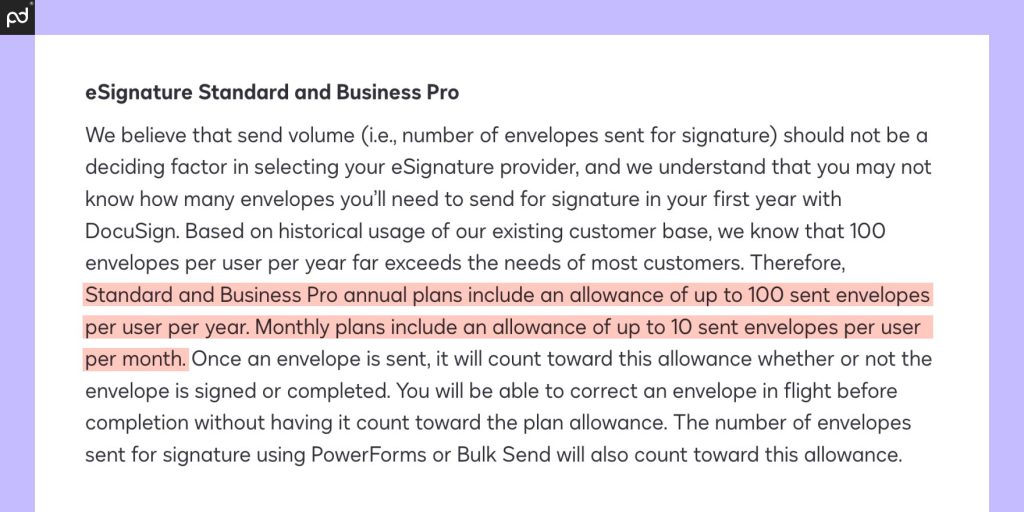
Many e-signature companies hide their usage caps behind “Fair Use” or “Reasonable Use” policies hidden in their Terms and Conditions pages, but these are vague about limitations.
With that in mind, be sure to read the fine print prior to choosing your e-signature vendor.
While it’s often possible to raise the transaction limit by purchasing additional seats for your plan or by talking with the sales team for customized pricing, the end result is the same:
When you exceed the transaction limit, expect to pay more in order to send additional documents.
Based on our research, PandaDoc is one of the only companies on the market today that offers truly unlimited sending.
The vast majority of e-signing companies will cap your usage.
Free plans
Often, plans in this category aren’t widely advertised and are intended as a perpetual free trial or a minimal-use plan for users who might need to sign a single document once every few months.
| eSignature solution | Free plan available? |
|---|---|
| DocuSign | ✓ |
| PandaDoc | ✓ |
| Dropbox Sign | ✓ |
| Foxit eSign | ✗ |
| signNow | ✗ |
| Adobe Acrobat Sign | ✗ |
| SignRequest | ✓ |
| SignEasy | ✗ |
While all companies that we reviewed for this article offer a free trial, only about half offered a free plan and the ability to test drive their software on a perpetual basis.
We’ll pass over the trials since they have a limited lifespan, but keep in mind that some platforms only default to a free plan after a free trial of a paid plan.
On its free plan, DocuSign gives users everything they need to send three documents per month for electronic signature.
Using DocuSign, it’s possible to add signature fields and basic information to your document, send documents to multiple recipients, and use the real-time audit trail features to track document changes.
You can also link to cloud storage in order to import your documents as a PDF.
Advanced features like template creation, bulk sending, and in-person signature collection aren’t available.
It goes without saying that the DocuSign free plan won’t be a great fit for power users.
It’s a no-frills, no-cost solution that works well for individuals and (very) small business owners who need digital signatures for a few documents every few months.
To get started, all you need is a DocuSign account.
Competitor highlights
For free plans, many competitors follow DocuSign’s lead by offering no-charge solutions that provide a very limited capacity to make use of the service.
This is usually done by capping the number of documents that users can send and restricting usable features.
Most services will allow you to sign an unlimited number of documents sent to you (from another sender) for free, but this can sometimes be accomplished without creating an account.
Many of the plans we reviewed offered unique features and variations on the free plan:
- Dropbox Sign caps signature requests at 3/month but offers free storage options via the Dropbox platform.
- SignRequest caps signature requests at 10/month but doesn’t allow users to set a signing order.
- PandaDoc offers unlimited e-signing and access to a payment processor for payment collection.
Of the three competitive options on our list, PandaDoc takes things to an entirely new level.
The Free eSign Plan from PandaDoc supports an unlimited number of users and allows businesses to send an unlimited number of documents — all at no cost!
We also empower senders with a payment gateway so that it’s possible to collect payments via credit card on signed documents — something that no other signature solution offers for free.
In fact, if you’re comparing PandaDoc to DocuSign and other competitors, a pro- or enterprise-level plan is usually required in order to access similar payment features, if those features are offered at all.
The best plan at this level: PandaDoc
We’re not trying to brag, but the ability to send an unlimited number of documents, onboard an unlimited number of users, and collect payments at no cost is something that you just won’t find in other signature software without a subscription plan.
Check out DocuSign and PandaDoc at the free level:
| Plan details | DocuSign | PandaDoc |
|---|---|---|
| Plan name | Free | Free eSign |
| Maximum number of users on plan | 1 | Unlimited |
| Minimum number of users on plan | N/A | N/A |
| Transaction / envelope limits | 3/month | Unlimited |
| Core product | ||
| E-signature capture | ✓ | ✓ |
| Real-time audit trail | ✓ | ✓ |
| Notifications | ✓ | ✓ |
| Language support | ✓ | ✓ |
| Mobile app | ✓ | ✓ |
| Reporting tools | ✓ | ✓ |
| E-signing features | ||
| Signing order | ✓ | ✓ |
| Send to multiple recipients | ✓ | ✓ |
| Bulk send | X | X |
| In-person signing | X | X |
| Collaboration tools | X | X |
| Signer attachments | X | X |
| Payment gateway | X | ✓ |
| Document prep | ||
| Drag & drop fields (PDF) | ✓ | ✓ |
| Create templates | X | X |
| From-scratch document builder | X | X |
| Pre-built template library | X | X |
| Form creation | X | X |
| Custom branding | X | X |
| Integrations & API | ||
| Import & storage | ✓ | ✓ |
| CRM | X | X |
| Productivity | X | X |
| API | X | X |
| Support | ||
| Email / ticketing support | X | ✓ |
| Chat support | X | X |
| Knowledge base | ✓ | ✓ |
| Phone | X | X |
| Premium support options | X | X |
Personal & entry-level plans
This collection of plans is intended for individuals, freelancers, and small business owners with limited usage requirements and a simplified signing process.
When reviewing DocuSign and its competitors, price played a major factor in determining what counted as a Personal plan.
| eSignature solution | Plan name | Price (Monthly) | Price (Annual) |
|---|---|---|---|
| DocuSign | Personal | $15 | $10 |
| PandaDoc | Essentials | N/A | N/A |
| Dropbox Sign | Essentials | $20 | $15 |
| Foxit eSign | eSign | N/A | $8 |
| signNow | Business Premium | $30 | $15 |
| Adobe Acrobat Sign | Acrobat Standard | $23 | $13 |
| SignRequest | Professional | $10 | N/A |
| Signeasy | Essential | $15 | $10 |
The hallmark for many entry-level plans is the presence of a restricted usage limit.
If the platform offers a free plan, this restriction is only a minor upgrade from that account.
For DocuSign users, the Personal plan increases the send limit from 3/month on the free plan to 5/month on the Personal plan.
Reusable templates also become available, allowing users to create standardized processes around frequently used documents.
However, this may not be all that useful, considering the usage restrictions.
Assuming you max out your envelope limit each month, expect to pay $15/month or $120/year to send a total of 60 documents in a 12-month period.
Competitor highlights
Nearly every competitor we looked at offers a plan that competes with DocuSign at this level.
Most companies offer more features or higher usage limits for a negligible increase in cost.
That’s especially true if you’re willing to purchase an annual subscription rather than paying month over month.
Here are the most unique highlights at this tier:
- Dropbox Sign offers unlimited document sending and signing for $15/month (annual). Alternatively, you can pick up a Essentials subscription via the main Dropbox website for around $25/month (annual). Both are personal plans and are limited to one user.
-
Adobe Acrobat Sign offers two plans for individual users. Both include the ability to sign, edit, share, and convert PDFs (exclusive feature) but are limited to 150 transactions per year and lack the e-signing compliance seen in higher-tier plans.
- Acrobat Standard runs $13/month (annual) and provides all the basic e-signing features you might need.
- Acrobat Pro costs $20/month (annual) and allows for payment collection, signature capture from websites, and (limited) bulk sending options.
- SignRequest offers the greatest selection of features at this level for $10/month (monthly). This plan includes unlimited signature, integrations, the ability to request signer attachments, and custom branding options.
At this tier, you’ll notice that many of the platforms we reviewed start to unlock portions of their core feature set.
Several of our top choices simply offer additional features and capabilities that aren’t covered by DocuSign’s e-signing tools.
That’s a huge consideration when considering DocuSign’s pricing and limitations.
Savvy shoppers may actually get more for their money by going with a DocuSign competitor that offers a broader scope of features.
The best free plans: PandaDoc Free eSign or SignRequest Professional
If you’re looking for a rock-solid e-signing solution at this level, PandaDoc and SignRequest are hard to beat.
SignRequest offers tremendous value at the lowest price.
While they still limit templates, the platform offers branding options, the ability to receive signer attachments, and much more for less than half of what most competitors offer.
On the other hand, the PandaDoc Free eSign plan is the way to go if you’re just trying to upload documents and get them signed.
Why? Because it’s free!
Unlike many of the paid plans, the Free eSign plan offers many of the document preparation and signing tools that other companies will require you to pay for.
Remember that PandaDoc also doesn’t have any send limits, so you aren’t limited to a specific number of envelopes or transactions.
Plus, you’ll have access to payment processing services at no fee, something that’s typically only available in paid plans (often at a high cost).
If that’s something you really need, but you don’t want to pay the extra costs for it, PandaDoc Free eSign is the best fit, even at this tier.
However, if you want to put some money behind your e-signing efforts without breaking the bank, take a look at SignRequest.
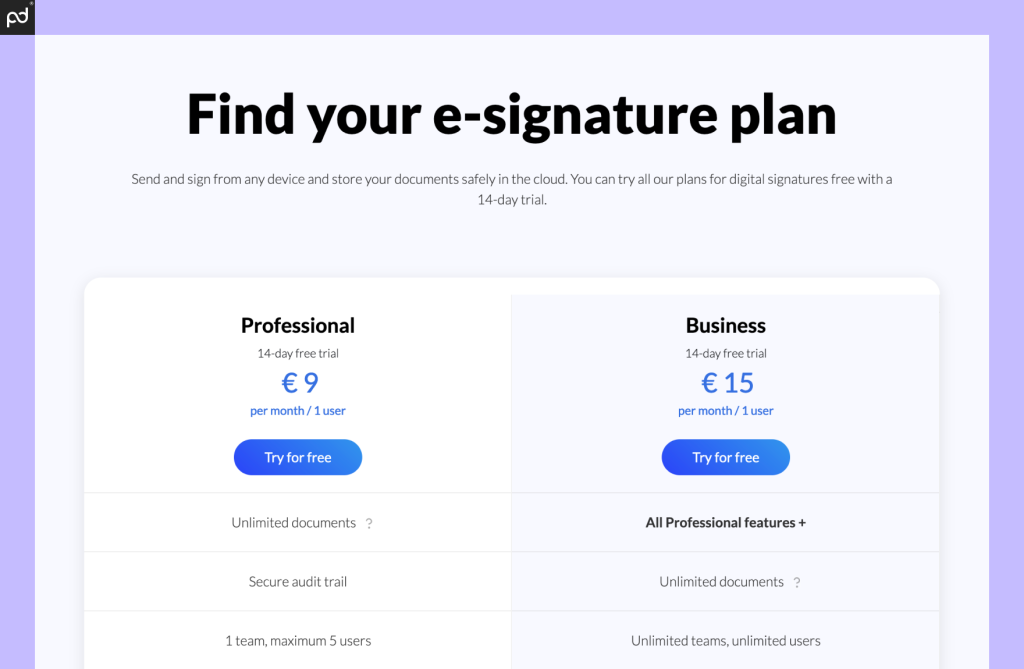
In our view, SignRequest provides the greatest number of features at the lowest price point, making it a clear winner for paid services at the entry-level tier.
The service offers many features, like custom branding and in-person signing, that are only available in higher-tiered plans from other e-signature companies.
If you’re looking for a streamlined signing platform that offers great value for cost, SignRequest is an excellent choice.
| Plan details | DocuSign | PandaDoc | SignRequest |
|---|---|---|---|
| Plan name | Free | Free eSign | Professional |
| Maximum number of users on plan | 1 | Unlimited | 5 |
| Minimum number of users on plan | N/A | N/A | N/A |
| Transaction / envelope limits | 5/month | Unlimited | Unlimited |
| Core product | |||
| E-signature capture | ✓ | ✓ | ✓ |
| Real-time audit trail | ✓ | ✓ | ✓ |
| Notifications | ✓ | ✓ | ✓ |
| Language support | ✓ | ✓ | ✓ |
| Mobile app | ✓ | ✓ | X |
| Reporting tools | ✓ | ✓ | X |
| E-signing features | |||
| Signing order | ✓ | ✓ | ✓ |
| Send to multiple recipients | ✓ | ✓ | ✓ |
| Bulk send | X | X | X |
| In-person signing | X | X | ✓ |
| Collaboration tools | X | X | X |
| Signer attachments | X | X | ✓ |
| Payment gateway | X | ✓ | X |
| Document prep | |||
| Drag & drop fields (PDF) | ✓ | ✓ | ✓ |
| Create templates | X | X | 5 |
| From-scratch document builder | X | X | X |
| Pre-built template library | X | X | X |
| Form creation | X | X | X |
| Custom branding | X | X | ✓ |
| Integrations & API | |||
| Import & storage | ✓ | ✓ | ✓ |
| CRM | X | X | X |
| Productivity | X | X | ✓ |
| API | $ | X | X |
| Support | |||
| Email / ticketing support | ✓ | ✓ | ✓ |
| Chat support | X | X | X |
| Knowledge base | ✓ | ✓ | ✓ |
| Phone | X | X | X |
| Premium support options | $ | X | X |
Standard plans
Designed for small businesses and teams with limited signing needs, most standard plans toe the line between the more-limited personal plans and the higher-tier business plans.
Plans in this category offer mid-tier pricing and features.
They’re a good fit for advanced freelancers and companies where a small collection of users need to handle the majority of the signing obligations.
While you may find some collaboration tools at this tier, advanced team administration and oversight tools are typically reserved for higher-end plans.
| eSignature solution | Plan name | Price (monthly) | Price (annual) |
|---|---|---|---|
| DocuSign | Standard | $45 | $25 |
| PandaDoc | Essentials | $35 | $19 |
| Dropbox Sign | N/A | N/A | N/A |
| Foxit eSign | eSign | N/A | $25 |
| signNow | Business Premium | $30 | $15 |
| Adobe Acrobat Sign | Acrobat Pro | $30 | $20 |
| SignRequest | N/A | N/A | N/A |
| SignEasy | Team | $30 | $20 |
The DocuSign Standard plan is a mid-tier pricing plan designed for small to medium teams that need a mix of signing, sending, and collaboration tools.
The plan runs $45/month or $25/month (annual) and offers a significant upgrade from the Personal plan in the previous tier.
At this level, DocuSign introduces collaborative commenting tools, some limited custom branding options, team reporting tools, and more.
The plan also expands from a single seat user cap to a 50-seat user maximum, which remains in place until the enterprise-level plans.
The Standard plan is the first plan where custom branding is among the DocuSign features offered to subscribers, and most competitors follow suit by offering similar branding and customization experiences at this level.
One notable exception is SignRequest, the winner in our previous category, which offers custom branding options on their entry-level plan.
Additionally, most plans we looked at in this category lack integration with CRMs like Salesforce or Microsoft Dynamics.
While DocuSign does offer integrations with document storage platforms (Dropbox, Google Drive, etc.) and productivity integrations like Google Workspace and Microsoft 365, most DocuSign integrations require an enterprise plan.
However, it’s important to point out that the most notable difference between this tier and the previous tier has nothing to do with functionality or ease of use.
The biggest changes come down to the number of documents that users can send.
DocuSign users on the Personal plan can only send five envelopes each month.
With the Standard plan, standard usage rates apply, allowing envelopes to be sent at a rate of around 10/month (max 100/year on the annual plan).
You can raise your usage limits by adding additional seats, or you might be able to customize those limits by talking to a sales rep for enterprise-level pricing options.
If you’d rather avoid usage and transaction limits entirely, plans at this tier are a strong starting point, as other brands also raise restrictions or (in some cases) remove them entirely.
Competitor highlights
While most DocuSign competitors follow a similar trajectory in their product offering, there are a few key features that stand out for users who want to consider other options:
- PandaDoc offers a create-from-scratch document editor starting with the Essentials plan. Using the editor, users can build documents from the ground up. This helps teams to combine intuitive document creation and management with an ironclad e-signing solution.
- Foxit eSign offers affordable eSigning with a 500 document/year cap. At $300/year ($25/month), it’s great for users who need a signing tool with no monthly cap. However, the plan expires after a year or when the transaction limit is reached.
- Adobe Acrobat Sign offers custom branding options and PDF editing at this tier, allowing for a level of customization and document collection beyond what DocuSign offers at a similar cost.
- Signeasy offers a pre-built template library and a full suite of Google integrations (Docs, Sheets, Drive, Gmail), rather than simplified import/export tools.
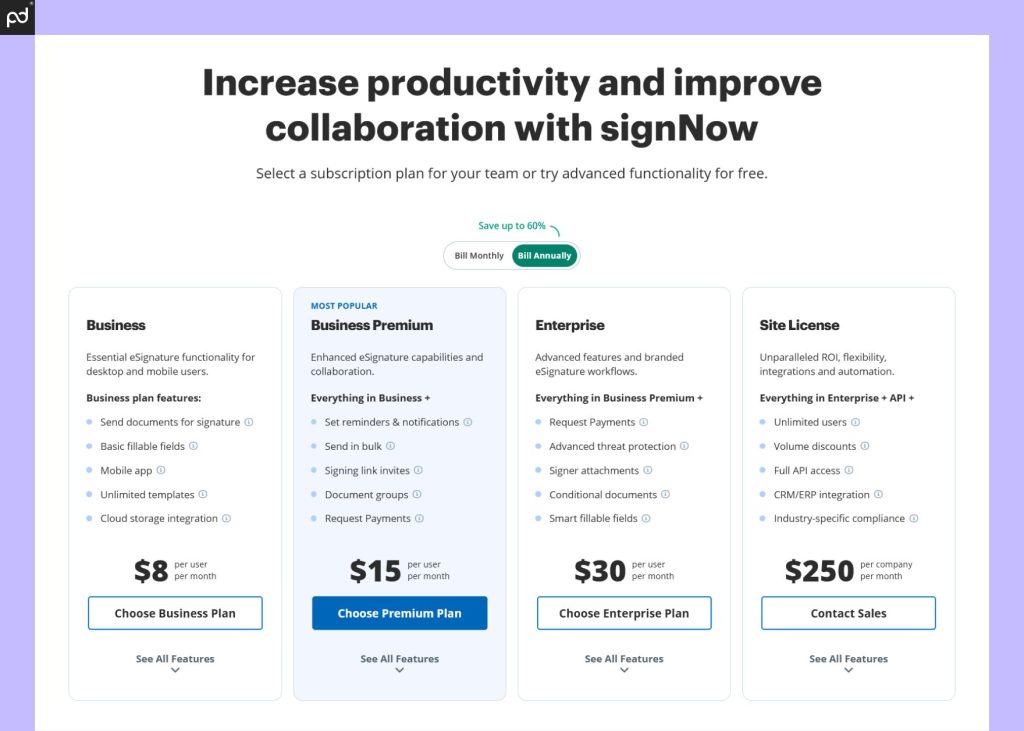
The best standard plan: Signeasy, SignRequest, or PandaDoc
The best plan at this level comes down to what you want to get out of an e-signature solution.
Signeasy is a great option for Google Workspace users.
The collection of native integrations is similar to PandaDoc for Google Workspace and allows you to add signature options to contract workflows set up inside Google.
If you’re already heavily integrated with Google, Signeasy acts as a natural extension of your flow by leveraging Google’s existing productivity and software suite to create a unified workflow.
At this level, PandaDoc offers the ability to create documents entirely from scratch and offers a broad selection of productivity integrations to connect your documents to the rest of your tech stack.
That, plus payment gateways, document analytics, and instant chat support mean that you’re getting a complete, end-to-end package from the very start.
Lastly, although we haven’t featured SignRequest heavily in this round because they don’t have a competitively priced plan at this tier, the Professional plan from the previous tier is still a formidable contender and should be considered.
Here’s a closer look at how these plans compare.
If you’re considering SignRequest at this stage, take a look at the previous section for more details on those plans/options.
| Plan details | DocuSign | PandaDoc | Signeasy |
|---|---|---|---|
| Plan name | Standard | Essentials | Team |
| Maximum number of users on plan | 50 | 2 | 5 |
| Minimum number of users on plan | N/A | N/A | N/A |
| Transaction / envelope limits | 100/year | Unlimited | Unlimited |
| Core product | |||
| E-signature capture | ✓ | ✓ | ✓ |
| Real-time audit trail | ✓ | ✓ | ✓ |
| Notifications | ✓ | ✓ | ✓ |
| Language support | ✓ | ✓ | ✓ |
| Mobile app | ✓ | ✓ | ✓ |
| Reporting tools | ✓ | ✓ | ✓ |
| E-signing features | |||
| Signing order | ✓ | ✓ | ✓ |
| Send to multiple recipients | ✓ | ✓ | ✓ |
| Bulk send | X | X | API Only |
| In-person signing | ✓ | X | ✓ |
| Collaboration tools | ✓ | X | Limited |
| Signer attachments | X | X | X |
| Payment gateway | X | ✓ | X |
| Document prep | |||
| Drag & drop fields (PDF) | ✓ | ✓ | ✓ |
| Create reusable templates | ✓ | ✓ | 5 |
| From-scratch document builder | X | ✓ | X |
| Pre-built template library | X | ✓ | ✓ |
| Form creation | X | X | X |
| Custom branding | ✓ | X | X |
| Integrations & API | |||
| Import & storage | ✓ | ✓ | ✓ |
| CRM | X | X | Limited |
| Productivity | ✓ | ✓ | Limited |
| API | $ | X | $ |
| Support | |||
| Email / ticketing support | ✓ | ✓ | ✓ |
| Chat support | X | ✓ | ✓ |
| Knowledge base | ✓ | ✓ | ✓ |
| Phone | X | X | X |
| Premium support options | $ | $ | X |
Business & pro-level plans
As you’ve probably guessed, plans in this category are designed for businesses operating just shy of the enterprise level.
We define plans in this category as the most expensive plan before the enterprise tier, meaning that these plans have the greatest amount of features available before a custom configuration is required.
This category typically sees the introduction of high-end integrations, form creation, and bulk sending, as well as custom branding and payment gateways (if those features haven’t been introduced on other plans).
| eSignature solution | Plan name | Price (monthly) | Price (annual) |
|---|---|---|---|
| DocuSign | Business | $65 | $40 |
| PandaDoc | Business | $65 | $49 |
| Dropbox Sign | Standard | $65 | $50 |
| Foxit eSign | eSign Pro | N/A | N/A |
| signNow | Enterprise | $50 | $30 |
| Adobe Acrobat Sign | Acrobat Pro for Teams | N/A | $24 |
| SignRequest | Business | $16 | N/A |
| SignEasy | Business Plus | $60 | $50 |
DocuSign’s Business Pro plan is designed to help businesses optimize their signing process with advanced features and automation tools.
With Business Pro, DocuSign introduces payment collection, bulk sending tools, signer attachments, and even template locking.
You’ll also see the addition of more advanced form fields in this category, including the ability to include drop-down forms, radio buttons, and approve/decline fields while preparing documents.
Unfortunately, many of these features feel long overdue since competitors like PandaDoc and SignRequest offer advanced fields as part of their lower-tier platform subscriptions.
The Business Pro plan also offers PowerForms, which are documents that can be built and embedded into websites.
However, many e-signing solutions offer a form builder at this tier, so you have options if you need to break away from DocuSign in search of greener pastures.
Despite offering several new features, DocuSign still keeps most integrations — including all CRM and ERP integrations — locked at the Enterprise-level tier.
While cloud storage integration options like Google Drive, Box, or Dropbox are available for fast importing, many critical CRM integrations are simply unavailable unless you’re willing to work with a sales team to build an enterprise-level solution.
That’s a major shortfall, and one that many DocuSign competitors have used to differentiate themselves.
DocuSign Standard vs. Business Pro
Before we get to the competitors, it’s worth taking a quick look at the difference between DocuSign’s Standard and Business Pro plans.
Business Pro adds a variety of features, but many of these will only be useful in certain scenarios.
The main features are as follows:
Signer attachments
Essential if signers are required to send documentation back as part of the signing process. (This can be found earlier in plans from Dropbox Sign and Acrobat Sign.)
Advanced form fields
Helpful when providing forms that require more complex input, such as selections from a menu or approving specific line items. (Found earlier in all PandaDoc, signNow, and Signeasy plans.)
Payment collection
Useful if you need to issue forms that have payment requirements.
Great for invoicing or for collecting deposits and reservation fees. (Found earlier in PandaDoc, signNow, and Adobe Acrobat Pro plans.)
Form creation
Allows users to create forms and embed those forms into websites.
Form data is collected and aggregated on the backend. (Found earlier in Adobe Acrobat Pro and Dropbox Sign plans.)
Bulk sending
Useful if you need to send a huge number of unique documents and emails at once. (Found earlier in Dropbox Sign, signNow, and Acrobat Pro plans.)
SMS/phone authentication
Provides an additional layer of verification for signers by relying on smartphones and text messages for two-factor authentication. (Found earlier in SignRequest and Foxit plans.)
You’ll need to contact the sales team to have this added to your Business Pro plan.
For the right user, many of these options will make perfect sense.
The addition of these features help power users consolidate the signing process into a single, streamlined workflow rather than handling these necessary tasks via third-party tools.
Before buying, consider the scale of your operation and what tools you need to grow your business.
If you’re not operating at a scale where the features make sense, switching up from Standard to Business Pro may only offer limited value.
Competitor highlights
At this level, DocuSign challengers are offering their best solutions at relatively competitive prices.
However, while pricing is a factor, it’s also important to note the shift toward integrations and scalability offered on higher-tier plans.
Many plans at this level are focused on helping to scale your e-signing workflow or integrate e-signing more effectively with the rest of your tech stack.
While DocuSign is somewhat stingy with its integrations, many solutions offer robust integrations at this level to create a more efficient signing process.
Here are a few of the key takeaways from most DocuSign competitors:
- PandaDoc offers document editing, content management tools, and native integrations with 10+ CRMs at this level. Salesforce and Zapier integrations are also available for an extra charge, as are features like bulk sending, team workspaces, and form creation.
- Adobe Pro for teams offers PDF editing, payment collection, and bulk sending but it requires an annual commitment upfront. This tier also switches from the single-user plans to the scalable team plans.
- SignRequest remains the most affordable plan, however the plan lacks a document editor and will force any contract changes/revisions to be handled via other software tools.
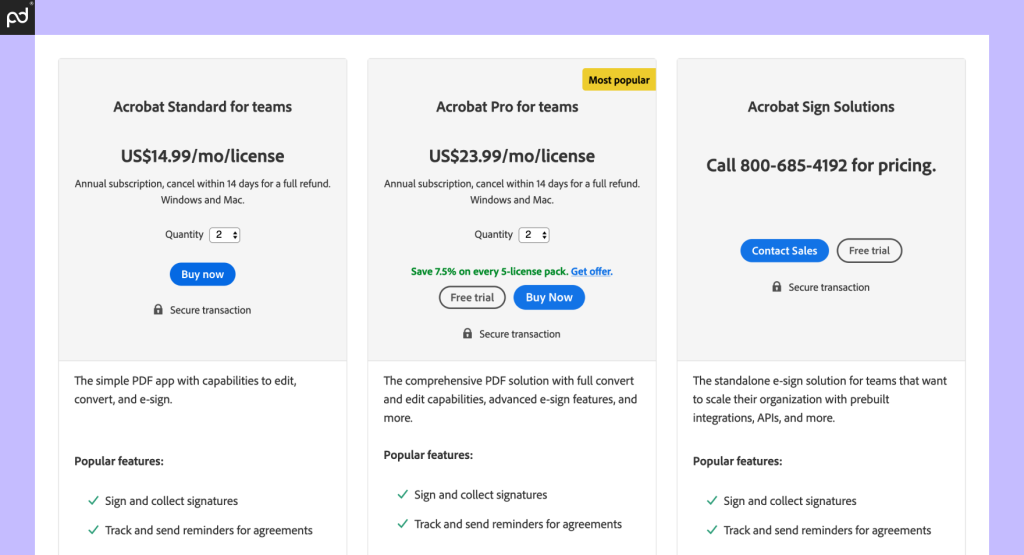
Best business plan: PandaDoc or Adobe Acrobat Sign (or SignRequest)
We’re proud to recommend PandaDoc as the best solution for business and pro-level users.
We’ve worked hard to ensure that our plan has everything customers need, from key integrations to the ability to design important business documents from scratch.
If you’re looking for an all-in-one solution that combines ease of use, simple user and content management, and maximum flexibility, PandaDoc is the right solution for you.
Adobe Acrobat might also be a great option to consider if you work with a lot of PDFs.
The ability to edit PDFs directly is a benefit that is both useful and highly unique.
But there are a few points you should consider before signing up:
Signatures acquired through Adobe Acrobat Standard/Pro aren’t as secure as those captured with Acrobat Sign
While Adobe isn’t clear regarding how these signatures are less secure, it’s mentioned explicitly on their website.
This could have a potential impact on how your documents hold up to legal scrutiny.
Adobe also limits transactions to 150 documents per user/year
So, while the price is attractive, these plans have hard limits that could impact your bottom line.
Integrations are limited to enterprise plans
If you want to integrate Adobe into your tech stack, be prepared to pay for enterprise-level pricing.
Adobe changes their plans often
We’ve updated this and other documents for years.
Adobe regularly changes their plans, rebrands products, and adds/removes features from their signing plans.
Lastly, we also want to highlight SignRequest. All SignRequest plans are so cost-effective that they’re impossible to ignore.
If you’re considering an enterprise-level solution, SignRequest’s Business plan is still worth a look.
| Plan details | DocuSign | PandaDoc | SignRequest | Adobe |
|---|---|---|---|---|
| Plan name | Business Pro | Business | Business | Acrobat Pro for Teams |
| Maximum number of users on plan | 50 | Unlimited | Unlimited | 250 |
| Minimum number of users on plan | N/A | N/A | N/A | N/A |
| Transaction / envelope limits | 100/year | Unlimited | Unlimited | 150/year |
| Core product | ||||
| E-signature capture | ✓ | ✓ | ✓ | ✓ |
| Real-time audit trail | ✓ | ✓ | ✓ | ✓ |
| Notifications | ✓ | ✓ | ✓ | ✓ |
| Language support | ✓ | ✓ | ✓ | ✓ |
| Mobile app | ✓ | ✓ | X | ✓ |
| Reporting tools | ✓ | ✓ | X | ✓ |
| E-signing features | ||||
| Signing order | ✓ | ✓ | ✓ | ✓ |
| Send to multiple recipients | ✓ | ✓ | ✓ | ✓ |
| Bulk send | ✓ | $ | $ | ✓ |
| In-person signing | ✓ | X | ✓ | X |
| Collaboration tools | ✓ | ✓ | X | ✓ |
| Signer attachments | ✓ | X | ✓ | ✓ |
| Payment gateway | ✓ | ✓ | X | ✓ |
| Document prep | ||||
| Drag & drop fields (PDF) | ✓ | ✓ | ✓ | ✓ |
| Create reusable templates | ✓ | ✓ | 5 | ✓ |
| From-scratch document builder | X | ✓ | X | X |
| Pre-built template library | X | ✓ | X | X |
| Form creation | ✓ | $ | X | ✓ |
| Custom branding | ✓ | ✓ | ✓ | ✓ |
| Integrations & API | ||||
| Import & storage | ✓ | ✓ | ✓ | ✓ |
| CRM | X | ✓ | X | ✓ |
| Productivity | ✓ | ✓ | ✓ | ✓ |
| API | $ | $ | $ | X |
| Support | ||||
| Email / ticketing support | ✓ | ✓ | ✓ | ✓ |
| Chat support | X | ✓ | X | X |
| Knowledge base | ✓ | ✓ | ✓ | ✓ |
| Phone | X | X | X | ✓ |
| Premium support options | $ | $ | X | $ |
Frequently asked questions
-
Depending on the plan you choose, the cost for DocuSign eSignature ranges from $15 to $65 per month (cheaper with an annual subscription). Enterprise pricing is also available.
More expensive plans offer more features, including bulk sending, customized branding, and the ability to send an unlimited amount of documents.
However, unlimited plan pricing assumes that you will only send 100 envelopes per year. For high-volume senders, this means that you may end up paying significantly more due to unexpected usage caps.
If you feel that you’re likely to exceed these usage caps, you can contact DocuSign support. You might also consider switching to a document management solution with unrestricted usage.
-
DocuSign envelopes function in the same way that a traditional envelope works. Often, you can bundle multiple documents into a single envelope.
For example, assume that you need to send a hiring packet to a prospective employee with multiple documents that need to be signed. You could send the documents in a single envelope that goes first to the employee, then to the hiring manager and the corporate office.
Sending all of those documents at once, to all of those individuals at the same time, would count as one envelope.
However, after you sent those documents, assume that you also needed to send an invoice to a client. Sending that single document to a single entity would also count as an envelope.
Envelopes can be tricky, and you only get 100 of them per user/seat on any DocuSign plan, so use them wisely.
-
DocuSign API plans run from $75 to $720+ per month (cheaper with an annual subscription) and are divided by usage limits and features.
Developer Accounts are free and have Enterprise-level features enabled, but they are used only for solutions development and can’t actually function. To go live with your solution, you’ll need to buy an API plan.
These plans offer considerably more flexibility regarding volumes. Every plan offers the option to purchase higher transaction volume limits, which creates a highly flexible and customizable purchasing solution.
API integrations require certifications before they are pushed to a live state.
-
The biggest difference between DocuSign and PandaDoc APIs comes down to the available fields and how the API is designed to function.
DocuSign API offers embedded signing, basic field usage, and authentication, as well as template generation. On the other hand, PandaDoc API allows for the addition of dynamic content and customizable variables due to its capabilities with its native document editor.
If you’re looking for a way to build customizable documents as part of your API, PandaDoc is the better choice. If you just want to embed a signing solution into PDF documents, both APIs are capable, but PandaDoc doesn’t have transaction limits.
-
The biggest difference between the PandaDoc Free eSign Plan and the paid plans is the ability to access the onboard document editor.
Users who just need to sign and send documents (and collect payments) will find everything they need to perform those tasks with a free account.
However, users looking for an end-to-end document management, creation, and signature solution will want to look at paid plans for maximum control throughout the entire document lifecycle.
-
Ultimately, it’s up to you to decide which electronic signature solution is right for you, but we hope this guide to DocuSign pricing and more helps you determine your best fit.
Across every e-signature company, some functionality is standardized.
Mobile apps for Android and iOS, for example, are commonplace across nearly all DocuSign competitors, but every plan varies slightly from the DocuSign service.
While you’re considering your options, we recommend trying out the PandaDoc Free eSign Plan or signing up for a free demo to see exactly how PandaDoc can shake up your document creation process.
Or, if you want to test drive everything yourself, sign up for a free 14-day trial for a hands-on feel of what the platform can do. We know you’ll love it.
Disclaimer
Parties other than PandaDoc may provide products, services, recommendations, or views on PandaDoc’s site (“Third Party Materials”). PandaDoc is not responsible for examining or evaluating such Third Party Materials, and does not provide any warranties relating to the Third Party Materials. Links to such Third Party Materials are for your convenience and does not constitute an endorsement of such Third Party Materials.
Originally published April 16, 2018, updated April 24, 2024


